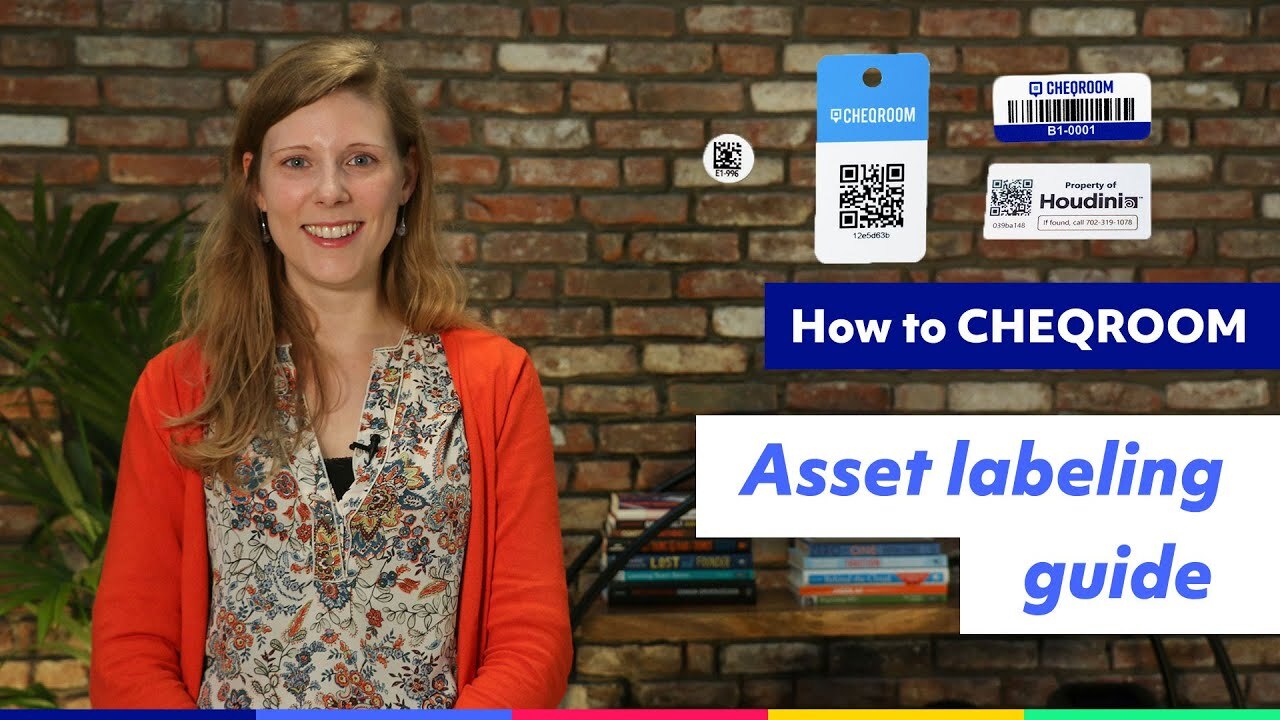
Your definitive guide to asset labeling
Cheqroom’s mission is all about helping you manage and keep track of your valuable assets with the best possible asset management software. An essential part of this process involves proper asset labeling.
TL;DR? watch this video!

You probably have tons of questions, and we’re here to help you understand the whole thing:
- What is asset labeling?
- Why is asset labeling important?
- What to label and what not to label?
- What information should I include on my labels?
- What's the difference between unique and non-unique codes?
- What numbering system should I use?
- What are the right barcodes for asset labels?
- What’s the best place to put my asset labels?
- Which material to use?
What is asset labeling?
The first step is understanding what an asset tag is. These (small) labels contain information about the assets like brand, serial number, or even reservation history. Find some examples here.
Now, let’s move on to the reason you’re here: What on earth is asset labeling? You can already guess it; it’s when you assign tags to certain assets. By doing so, you’re giving a unique digital identity to each piece of your equipment by assigning it a specific code or number.
“Asset labeling is the process of giving a unique digital identity to each piece of your equipment.”
This will make sure your operations run smoothly, enabling you to find the right equipment when needed. It's especially convenient if all items are indexed in an asset management system. 😏

Why is asset labeling important?
There are a number of reasons why you should attach asset tags to your equipment; it’s to:
- make it easier to identify assets quickly;
- indicate what equipment belongs to you and your organization;
- make it possible to run audits on equipment;
- save countless hours by scanning asset tags with a mobile app or barcode scanners;
- avoid confusion when communicating about equipment;
- use your asset management system to its full potential.
Essentially, asset labeling is vital for maintaining your equipment and ensuring it remains in good working condition.
How to use asset tags?
To label or not to label, that’s the question.
When labeling, one decision you'll need to make is determining which items truly require it. It's unlikely you'll label everything, so it's best to start with items of higher value.
Items that DO need an asset label:
- Movable assets: Consider items that are frequently moved or used by external individuals, like freelancers. And it doesn’t stop at labeling individual pieces of equipment. Labeling bags or kits used for transporting equipment, such as flight cases or camera bags, often makes sense. Give inefficiency no chance, and incorporate an equipment check-out software. For instance, linking your asset labels to Cheqroom allows you to hold your team accountable when equipment isn't returned.
- Fixed assets: While movable assets are often the most prominently labeled, labeling some immovable or difficult-to-move equipment may also be beneficial. This is to make inspection, maintenance, or scheduling repairs easier.
- Consider theft risk: Think about which items might be more likely to be stolen. More expensive items may be better candidates for labeling. A label indicating "Property of" can act as a deterrent to theft. However, before you start labeling, think about the implications. For instance, labeling unencrypted hard drives with sensitive information might not be wise. For security reasons, organizations sometimes choose not to include information that could draw unwanted attention to the assets.
Items that DON’T need an asset label:
- Consumable items: Think of tape, light color filters, light cleaning fluids, paper backgrounds for shoots, and aerosol cans. You typically don’t have any long-term plans for these, and they probably won't even return to the gear cage at the end of the shoot.
- Items that are fragile or of particular value: These assets, like art or antiques, may lose value if you attach an asset label. If you decide to label these items, take extra care with the placement and material used.
What information should I include on an asset label?
Deciding what information to include and exclude is crucial for your labeling. ☝🏼
Asset labels have limited space, so you need to be selective about what to include.
You can add:
- the name of the item;
- ‘property of’ + your organization’s name;
- some basic specs such as size, weight, and serial number;
- a scannable code, so you can use mobile apps or barcode scanners.
However, after this, you will encounter questions specific to your organization and database system. So, make sure to think carefully about this before filling out your asset labels!
Word of advice: Less is more!

What's the difference between unique and non-unique codes?
One of the key decisions you will need to make is whether you want to use unique or non-unique codes on your asset labels.
Unique codes
Unique codes are, as the name suggests, unique identifiers that are assigned to each individual asset. These codes are typically alphanumeric and can be generated in any way that makes sense for your organization. The key is that each piece of equipment has its own unique code that is not shared by any other asset.
The main advantage of unique codes is that they allow for precise tracking and management of individual assets. If each piece of equipment has a unique code, you can track its usage, maintenance, and location accurately. This can be particularly beneficial for high-value or critical assets.
Non-unique codes
Non-unique codes, on the other hand, are identifiers that may be shared by multiple assets. This is often the case when assets are identical or very similar, and it's not necessary to distinguish between individual units. Non-unique codes can be helpful when tracking types of equipment rather than specific units.
Non-unique codes are generally simpler and easier to manage. If you have a large number of identical assets and it's not necessary to track each individually, using non-unique codes can save you time and effort. However, it does mean that you won't have the same level of detail in your tracking and management.
The choice between unique and non-unique codes will depend on your specific needs and circumstances. It's important to think carefully about what level of detail and precision you need in your asset tracking before making a decision.

What numbering system should I use?
Using a sequential numbering system, such as a "Plus One" list of numbers, is the most straightforward method to number your assets.
Avoid numbering incrementally with leading zeros (like 000001), as many spreadsheet software programs drop leading zeroes.
Some organizations prefer to be more specific by using an alphanumeric structure in their codes, such as A00123 or C00456. And while these methods are effective, it's important to remember that you can do whatever you want with your system – it’s yours!
To help you identify and understand your assets more easily, consider assigning abbreviations such as CA for cameras and MI for microphones, followed by a numbering system. However, if you're using barcodes, keep in mind that they might be totally unique and different from your ideas, so you’ll have to reconcile them.
Be careful with certain fonts — Ensure that you select a typeface that clearly distinguishes between 0 (zero) and O (letter O), as well as l (lowercase L) and I (uppercase I).
Why shouldn’t I rely on tags from the manufacturer?
Using the labels provided by a manufacturer may seem simple and easy. However, this approach often has some shortcomings.
For instance:
- Uniqueness: They’re not guaranteed to be unique, either to the piece or - especially - to you and your organization.
- Scannability: They may not be readable by your barcode scanner or compatible with your equipment management apps.
- Placement: Labels can be placed in areas that are convenient during manufacturing but not during usage or scanning.

What are the right barcodes for asset labels?
The barcode is often the most essential component of an asset tag. Its scannable section comprises various "symbologies" that determine how data gets encoded and decoded in a scannable barcode.
The most common two kinds of barcode symbologies for asset management are called Code 39 and Code 128. These are different from the EAN or UPC barcodes on all retail products.
Once you have everything labeled, you have the possibility to follow your equipment everywhere by using barcode tracking.
Feeling a bit swamped?
We know that labeling can be a bit tricky. That's why we have created asset labels specifically for your AV and IT equipment. They are top-notch, the perfect fit, and carry all the necessary info.
Why not take this quick quiz to find out which labels are the perfect match for your gear?
Got everything figured out in terms of asset labeling? But are you not entirely sure how to use them in the most efficient way? Find out what Cheqroom can do for you. Start a free 7-day trial today!
Get the best Asset Labels for your AV gear now.
Once you're all set, you can easily order your labels straight from our Asset Label Store and get your dream labels right at the front of your door.
More blog articles














